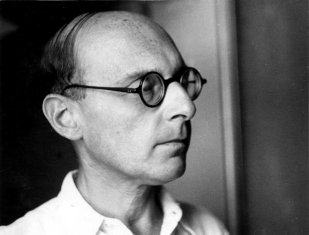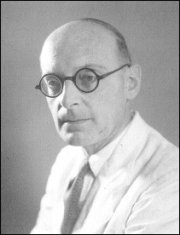|
|
Paul Ben-Haim (Composer, Arranger) |
|
Born: July 5, 1897 - Munich, Germany
Died: January 14, 1984 - Tel Aviv, Israel. |
|
Paul Ben-Haim was an eminent German-born Israeli composer and teacher, leader of the Eastern Mediterranean school, synthesized Eastern and Western approaches to music in compositions of exceptionally fine craftsmanship.
Paul Ben-Haim was born Paul Frankenburger in Munich into the family of the eminent German law professor, Frankenburger, at the end of the 19th century. He studied composition with Friedrich Klose and Walter Courvoisier and conducting and piano with Berthold Kellermann at the Munich Academy of Arts from 1915 to 1920. He was assistant conductor to Bruno Walter and Hans Knappertsbusch at the Munich Opera from 1920 to 1924, and he was the conductor of the Opera of Augsburg from 1924 to 1931. Returning to Munich in 1931, he devoted himself to composition. In that year he established himself in German music with Pan, a tone poem for soprano and orchestra; an oratorio entitled Yoram, based upon a biblical text; and his Concerto Grosso.
When the Nazis came to power in 1933, the composer emigrated to Palestine and there changed his surname from Frankenburger to Ben-Haim. He accompanied and arranged music for folk singers, an experience which brought the influence of Middle Eastern music to bear upon his compositional style. In 1937 he wrote a string quartet which synthesizes European and Eastern Mediterranean music, and in 1939 he wrote his Variations on a Palestinian Tune for chamber trio. In 1941 he wrote an especially well-received quintet which may be said to consummate his initial efforts to fuse the music of his adopted land with the European tradition in which he had been trained.
Paul Ben-Haim's First Symphony was completed on the day in 1940 when France fell to the Nazis, and this work may be said to express the tragic and intense period of history in which it was composed. In addition, Ben-Haim's First Symphony was the first real symphony to be composed in Palestine. His Second Symphony, composed in 1945, returned to the pastoral Mediterranean moods of the composer's work of the late 1930s. Both symphonies were first presented by the Palestine Symphony Orchestra.
Paul Ben-Haim was the leader of a group of Palestinian musicians, many of them European émigrés, who developed a fusion of Eastern and Western musical traditions. Isolated during World War II, this group, many of whom had been thoroughly trained in European conservatories and academies of music, studied the music of the Middle East and came to incorporate its melodic and rhythmic character into the forms of Western music. Ben-Haim developed a method for notating the complex rhythms and the melodies of Middle Eastern folk music, which facilitated the merging of these traditions in modern Israel.
In 1953 the conductor Serge Koussevitzky had the idea of a "King David Festival" to coincide with the commemoration of Jerusalem's 3000th anniversary. Serge Koussevitzky died before the works commissioned for the festival were all completed, but the Koussetvitsky Foundation did commission and Ben-Haim did complete The Sweet Psalmist of Israel, an orchestral work in the concertante style which successfully synthesized Eastern and Western elements of music. He received the Israel State Prize for this composition in 1957. Leonard Bernstein conducted it in New York in 1959, and it remained one of Ben-Haim's most widely admired works.
Paul Ben-Haim was director of the Jerusalem Academy of Music (1949-1954). He was also a professor of composition at conservatories in Tel-Aviv and Jerusalem , positions which, in addition to his leadership of the Eastern Mediterranean school of composers, made him a principal figure in Israel's musical life. On the practical side, he was influential in the development of music education in Israel, and he also helped to form the musicians' union in his new country. He was awarded the Joel Engel prize of the city of Tel-Aviv on several occasions. An automobile accident in 1972 brought a premature end to his creative work. He remained active in the musical life of Israel until his death in Tel-Aviv in 1984 at the age of 86.
Although considered neo-classical by some critics and late Romantic by others, there is no disagreement about the high professional standards of Paul Ben-Haim's work. Perhaps because of their identification with the new state of Israel, some critics place his symphonies in the late Romantic tradition of nationalism, or perhaps national style, which includes the European composers Sibelius and William Walton. However, a typical work, the Sonata for Solo Violin, written for the English violinist Yehudi Menuhin, shows a fusion of traditional, European classical elements and the drone and hora rhythms of Middle Eastern music. The Eastern folk music elements are most present in his vocal compositions, the songs and the psalms, which are perhaps his most lyrical compositions. Three Songs without Words, vocalises for high voice and piano, is among his most acclaimed works.
In Paul Ben-Haim one can see two of the principal elements in modern European music - the late Romantic school of composers and the neo-classicism of Igor Stravinsky and others. However, just as Béla Bartók, through an intensive study of East-European folk music, developed a style of composition in which new melodic and rhythmic materials are used in the traditional forms of Western music, so Ben-Haim's work, in drawing upon the folk music of the Middle East, provides fresh materials for use in traditional forms. Composers who synthesize diverse elements in their music, such as Paul Ben-Haim, perhaps should not be narrowly categorized in terms of any of the individual strands which they have woven into their music. He was especially successful as a composer of vocal works. |
|
Works |
|
Orchestral:
Concerto Grosso (931)
Pan, symphonic poem (931)
2 symphonies: No. 1 (1940; Tel Aviv, June 5, 1941) and No. 2 (1945; Tel Aviv, February. 2, 1948)
Evocation for Violin and Orchestra (1942)
Concerto for Strings (1947)
Piano Concerto (1949; Tel Aviv, February 1, 1950)
Fanfare to Israel (1950; also for Band)
From Israel (1951)
The Sweet Psalmist of Israel (1953; Tel Aviv, October 18, 1956)
To the Chief Musician (958)
Violin Concerto (1960; Tel Aviv, March 20, 1962)
Dance and Invocation (1960; Tel Aviv, February 2, 1961)
Capriccio for Piano and Orchestra (Tel Aviv., September 25, 1960)
Cello ConceJto (1962; Limburg, December 14, 1967)
The Eternal Theme (1965; Tel Aviv, February 12, 1966)
Divertimento for Flute and Chamber Orchestra (1971-1972)
Chamber:
String Trio (1927)
String Quartet (1937)
Clarinet Quintet (1941)
Serenade for Flute and String Trio (1952)
Sonata for Solo Violin (1953)
3 Pieces for Cello (1973)
Piano pieces, including a Sonata (1953)
Vocal:
Yoram, oratorio (1931)
Liturgical Cantata for Baritone, Chorus, and Orchestra or Organ (1950)
A Book of Verses for Chorus (1958)
Visiion of a Prophet, cantata for Tenor, Chorus, and Orchestra (1959)
Lift up Your Heads, motet for Soprano and 8 Instruments (1961)
3 Psalms for Solo Voices, Chorus, and Orchestra (1962)
A Hymn to the Desert for Soprano, Baritone, Chorus, and Orchestra (1963)
Myrtle Blossoms from Eden for Soprano or Tenor, Alto or Baritone, and Piano or Chamber Orchestra (1966)
Kabbalai Shabbat (Friday Evening Service) for Soprano, Tenor, Chorus, and Organ or 9 Instruments (1967)
6 Sephardic Songs for Chorus (1971). |
|



|
|
Source: Bakers Biographical Dictionary of 20th Century Classical Musicians (1997); Encyclopedia of World Website
Contributed by Aryeh Oron (July 2011) |
|
Paul Ben-Haim : Short Biography | Arrangements/Transcriptions: Works | Recordings |
|
Links to other Sites |
|
Paul Ben-Haim Discography
Encyclopedia of World Biography on Paul Ben-Haim |
Paul Ben-Haim (Wikipedia) |
|
Bibliography |
|
Jehoash Hirschberg : Paul Ben-Haim (Tel Aviv: IMI, 1983; English. translation, 1990)
Hadassah Guttmann: The Music of Ben-Haim: A Performance Guide (Metuchen, New Jersey, & Guide London: Scarecrow Press, 1992) |
|
|